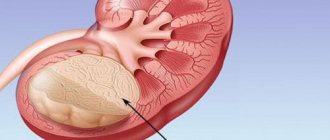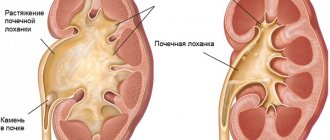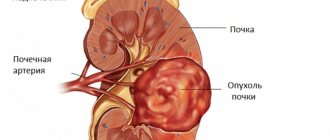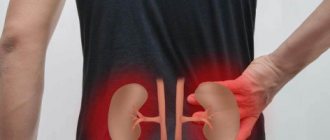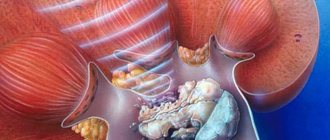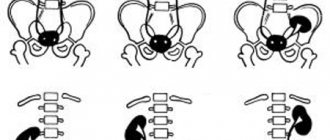In medicine, nephroptosis is defined as prolapse of the kidney, when this organ takes a position lower than usual. Due to increased kidney mobility, most people give up sports, but this is not true. According to experts in the field of medicine, physical activity must be present in the disease described, but only in a mild form and depending on the severity of the disease.
Fitness for kidney disease: who can?
As a rule, doctors allow physical activity when, after treatment, a person moves from the acute period of the disease to the recovery stage. Here, not just the type of load is selected, but also its mode, and necessarily individual rehabilitation therapy. The correct selection of a set of exercises depends on the initial diagnosis, age, and the physical shape the person was in before the illness. “The best thing is therapeutic exercises, which is also therapy,” says Anna Timofeeva. “Every little detail in this situation is very important, because excessive stress - long training, too frequent exercise - can weaken the body, which has not yet had time to recover.”
“When there are problems with the kidneys, it is better to focus on physical therapy and training under the supervision of a physical therapy specialist,” agrees Sergei Cherednichenko, a fitness gym instructor.
Impaired kidney function often leads to poisoning of the body with toxins, because one of the main functions is the removal of metabolic products from the body and the regulation of fluid, acid-base balance. With good muscle activity, metabolic products enter the blood and are actively excreted by the kidneys. Therefore, when choosing a particular level of physical activity, it is important to take into account existing problems with the excretory system.
What else can you do?
Patients with pyelonephritis should carefully engage in any sports; it is important not to overdo it and not to put a lot of stress on the body. Jogging at a moderate pace, skiing are allowed, and cycling is encouraged. Gymnastics for pyelonephritis should be carried out at a moderate pace, especially if the patient has one organ. If along with the pathology there is a kidney cyst, then jumping and jumping is prohibited. It is recommended to practice hardening, but under the strict supervision of a doctor, so as not to overcool the organs. Thermal baths and saunas have a beneficial effect on the body. But after it you can’t go into a cold shower - a warm one is recommended.
Source: https://etopochki.ru/nefrit/gnojnyj/lfk-pri-pielonefrite.html
Restoring health after acute kidney inflammation requires an integrated approach. It is necessary not only to prevent possible complications, but also to create maximum conditions for the rapid restoration of immune defense and normal functioning of the urinary system. Among all complex measures, exercise therapy for pyelonephritis and massage are excellent and effective methods of influencing the body of a person who has suffered an acute inflammatory process.
Content:
Fitness for kidney disease: is it useful or not?
We all know that a sedentary lifestyle worsens our health. Many functions of the body may fade, including excretory ones. Movement, on the contrary, gives all systems the impulse to “shake up” and restore their activity. “Under the influence of fitness training, the acid-base balance is better regulated and the kidneys function,” says Sergei Cherednichenko. “These positive changes are associated with changes in renal blood flow and the functioning of individual nephrons.”
Unfortunately, it is believed that if there is a kidney stone, you need to walk and jump more - then it will come out on its own. “People who have experienced an attack of renal colic at least once in their life will never give such advice! - Anna Timofeeva is convinced. “This is very dangerous and can lead to tragedy.”
Another common misconception is that even a healthy person can experience kidney prolapse due to running, jumping or strength training. “This will not happen if a person does not have a predisposition,” explains Sergei Cherednichenko. — Normally, a person’s kidneys may move slightly during breathing, moving the body, etc. with an amplitude of no more than 3-4 cm. If the kidney becomes mobile and, in a vertical position, moves downward from its bed by more than 5 cm, they speak of kidney prolapse (nephroptosis). This can be caused by injuries and blows to the lower back, sudden weight loss, unfavorable pregnancy and injuries to the birth canal during childbirth.” Outside of all these factors, stress does not lead to kidney prolapse. Nevertheless, take into account your condition, because the barbell that you lifted without problems before illness can lead to injury after it.
Metabolic functions
In addition, the kidneys maintain constant blood pressure under normal conditions and during blood loss, and it is in them that the main regulator of this indicator is located - the renin-angiotensin-aldosterone system (RAAS). Also, due to the selective permeability of capillaries in the parenchyma of this excretory organ, a balance of various electrolytes and osmotic components in the blood and tissues is ensured: sodium, potassium, calcium, magnesium, glucose, proteins, acids and many others. They are also involved in erythropoiesis, since it is in them that the special substance erythropoietin is produced - a stimulator of the synthesis of red blood cells in the bone marrow.
Fitness for kidney disease: what is allowed?
- Physiotherapy. As a rule, classes are held individually or in groups under the guidance of a physical therapy instructor. “The group selects patients with the same pathology,” explains Anna Timofeeva. — If you have kidney diseases such as pyelonephritis or urolithiasis, then the following types of physical therapy are optimal: dosed recreational walking; classic therapeutic massage; gymnastic classes."
- Another option is calm classes such as yoga , Pilates, calanetics, body balance. The load will increase gradually, depending on how you feel. Typically the workout lasts from 20 to 50 minutes.
- A good alternative to the fitness room is walking in the fresh air at a brisk pace . However, depending on your circumstances, walking on a treadmill, as well as an exercise bike or cross-trainer are also allowed. In winter you can go cross-country skiing or downhill skiing, in summer you can ride a bicycle or scooter. As you already understand, the main thing is not to get carried away with increasing loads and avoid bumps and falls. It is precisely because of the risk of falling that doctors do not recommend rollers for such people - of course, if you are not a master at them.
Whatever you do, be sure to do a moderate warm-up (10-15 minutes of walking) and monitor your heart rate, best with a heart rate monitor. “Exercises for the muscles of the back, lower back, abs, exercises for the legs should be performed at a slow pace, always controlling your breathing,” explains Sergei Cherednichenko. “On the machines, it is recommended to use a moderate weight that allows you to do 15 repetitions, and a sufficient rest interval between sets and exercises.”
[new-page]
Traditional methods of treatment
Traditional methods will be effective only if there is no need for surgical intervention. Such methods can be an excellent prevention of complications, reducing pain symptoms, but they will not be able to return a prolapsed kidney to its previous state. So, here are some of the most effective recipes for treating a prolapsed kidney at home:
- Sunflower seeds, pumpkin seeds, flax seeds and any nuts can be beneficial. Flaxseeds should be washed with clean drinking water, sprinkled with powdered sugar and fried in a dry frying pan. Take orally three times a day, a teaspoon, chewing well;
- Grind the stems of Kochia broom and pour boiling water in a ratio of 1:3. Brew the resulting mixture for about 12 hours, then strain thoroughly. Drink the resulting liquid three times a day, a quarter of a tablespoon;
- Now let's move on to taking healing baths. Chop oats and straw, mixing with water in a ratio of 1:20. The resulting mixture should be boiled over low heat for about an hour, then allowed to brew for several hours. The resulting solution should be used in its pure form for taking a bath;
- pour boiling water over a mixture of flax seeds, echinacea flowers, rosehip petals, and knotweed and leave for about 15 minutes. Take three times a day for one month.
Fitness for kidney disease: what not to do?
As you may have guessed, any loads with impacts and jumps are prohibited, as well as a sharp increase in intensity (tempo or weights). High-intensity classes like HIIT, Tabata, etc. are highly undesirable. Alas, following them, running, any jumping, and CrossFit are excluded. Strength exercises that you perform with straining (usually with heavy weights), as well as plyometric and speed training are prohibited. Nephrologists are not enthusiastic about visiting the pool - hypothermia can cause a relapse.
“Even physical therapy,” warns Anna Timofeeva, “is better to refuse against the background of a wave-like temperature reaction with periodic fever; for pain in the kidney area; with exacerbation of chronic pyelonephritis, relapses of glomerulonephritis; against the background of any urinary disorders.”
Etiology and risk factors
Pathological mobility is more common in women, since they are characterized by greater extensibility of the ligamentous apparatus compared to men, and can arise from a number of reasons that in one way or another cause weakness of the fixing apparatus. First of all, kidney nephroptosis can be caused by:
- a sharp loss of body weight, as a result of which the fat capsule of the organ becomes thinner and it becomes more mobile;
- injuries of the lumbar region or abdomen that violate the integrity of the fascia or destruct the muscular bed of the kidneys, for example, renal nephroptosis often accompanies retroperitoneal post-traumatic hematomas;
- sudden lifting of weights or professional sports, during which there is strong muscle tension and an increase in intra-abdominal pressure, but the constant influence of this factor stretches the ligamentous apparatus, under the influence of which the kidney can slide to a lower position;
- weakness of the muscular system, on the contrary, reduces pressure, and the function that fixes it also decreases, which is why nephroptosis and pregnancy or a sedentary lifestyle so often go side by side;
- In addition to the above-mentioned acquired causes, increased tissue extensibility may also be a consequence of hereditary predisposition, for example, in connective tissue diseases.
Fitness for kidney disease: figure
With all of the above, kidney disease is not an obstacle to working on your figure. That is, you can lose weight and build muscle, but gradually and within reasonable limits. We remind you that the physiological norm for changing your weight is up to 5% of body weight per month.
If you are keen on gaining muscle mass, avoid a high protein diet. “The kidneys are the main organ that removes the end products of protein breakdown,” says Sergei Cherednichenko. “With a diet rich in proteins, kidneys weakened by disease cope with their task worse, and this is fraught with health problems for other organs and systems of our body.”
Nutrition should be complete and balanced; food should contain carbohydrates, proteins and fats in the proportion recommended by the doctor. Don't be afraid that this will significantly slow down your athletic progress - in fact, gaining natural and beautiful muscle mass does not require the huge amount of protein that is sometimes recommended in the literature for bodybuilders. As for drinking during training, there are no general recommendations on this issue - everything is decided individually with your doctor. “The drinking regime requires a differentiated approach depending on the disease, but we limit water only in the acute period of nephrotic syndrome,” explains Anna Timofeeva.
Do not completely give up exercising if you have kidney disease - after all, a person cannot be healthy without movement!
Instrumental diagnostics
The first instrumental examination, which can already determine the main tactics for treating renal nephroptosis, is an ultrasound scan performed in various projections. In addition to basic information on the location of the organ and the degree of its deviation from the anatomically correct position, ultrasound examination reveals foci of inflammation and possible expansion of the entire collecting apparatus.
Doppler ultrasound (USDG), which examines the vessels adjacent to the kidneys, shows how well the circulatory system copes with supplying the organs with blood, assesses the speed of blood flow and the capacity of the vessels.
Excretory urography, that is, an x-ray of the urinary complex as a whole, indicates the depth of descent of the kidney towards the pelvis in relation to the lumbar vertebrae. This allows us to draw a conclusion about the stage that the disease has reached and detect all violations in the process of removing urine from the body.
Excretory urography for nephroptosis allows you to assess the degree of pathological prolapse of the kidney in relation to the lumbar vertebrae, and rotation of the kidney. The X-ray method of examining the urinary system allows one to estimate the time of urine excretion, identify anatomical lesions of the urinary organs, and monitor the dynamics of urine excretion.
In some cases, and if a detailed, layer-by-layer study of the urinary apparatus is necessary, I can recommend an MRI of the kidneys to the patient, but due to the paid examination, it is not included in the list of mandatory manipulations.
Traditional methods of treatment
Herbal therapy is one of the traditional methods of treating the disease.
Manual therapy
Although manual therapy has been an official medical specialty in Russia for about 15 years, most patients and doctors consider it a branch of traditional medicine. Chiropractors, as a rule, are skilled in visceral manipulations, with the help of which it is possible to restore normal anatomical relationships between internal organs. A doctor who knows this technique can normalize intra-abdominal pressure and individually select exercises for the abdominal and back muscles. This treatment can be recommended for the first and second degrees of nephroptosis.
Herbal therapy
In addition to herbs that are completely justified from a medical point of view, which have a beneficial effect on the movement of urine through the ureters and protect against infections in the urinary tract (bearberry, knotweed, lingonberry leaf, flaxseed), there are recommendations, the advisability of which is not entirely clear. For example, sitz baths with a hot decoction of oat straw are used as a method of treating nephroptosis. Before using any traditional methods, consultation with a specialist is necessary.
Set of exercises
There are several training methods for nephroptosis, but all of them are effective only in the first two stages.
After exercise therapy, when a kidney prolapses, a renal corset is immediately put on.
Exercises for nephroptosis according to Bubnovsky
Professor Bubnovsky has developed a set of exercises to raise the kidney when it subsides. The training takes place in a supine position. It’s worth starting with the simplest, and increasing the complexity of the training.
Exercise therapy looks like this:
- "Bike". You should use your imagination and “turn the pedals.”
- "Scissors". Raise your legs to a height of 10 cm from the floor. Imitate scissors.
- "Birch". Raise your legs straight, focusing on your shoulder blades, and support your lower back with your hands. Hold this position for as long as possible, at least 30 seconds.
- Slowly raise your straight legs, brought together, until they are perpendicular to the floor. As you exhale, lower them.
- Squeeze a soccer ball between your knees and hold for 10 seconds.
To start, 4-6 repetitions are enough. Then you should increase the amount to 10-12 times.
Gymnastics for grade 1 nephroptosis of the right or left kidney can be supplemented with exercises performed in the knee-wrist position (kneeling, resting your palms on the floor). Back bends are effective.
Yoga for nephroptosis
Photo from the site veda-journal.ru
Yoga during prolapse has a positive effect on all organs, in particular the kidneys. Moreover, it is indicated at stages 1 and 2 of the disease; at the latter, classes are allowed only after surgery.
Yoga for nephroptosis is performed lying on your back or sitting on the floor. The lesson program looks like this:
- "Boat". Sit down, straighten your legs, keep your back straight, place your palms on the floor. Then draw in your stomach, take a deep breath and exhale. Then, while inhaling, tilt your torso back and lift your legs up. The pose should resemble the English letter “V”, with your arms extended in front of you. Hold for 15-20 seconds. Do 2-3 repetitions.
- Lie on your back, straighten one leg, bend the other at the knee joint, and wait for yourself. Press with your hands on the bent knee for at least 10 seconds, resistance should be felt. Then change legs and do the same. Perform 2-3 times.
- Lie on your back, legs straight. Grab the back of your head with your hands clasped. Tighten your muscles, exhale, raise your upper body and legs by at least 10 cm. The feet are tense, pulled towards the face. Maintain this position for as long as possible. Perform 2-3 repetitions.
For a more pronounced therapeutic effect, it is necessary to combine yoga and exercise therapy for nephroptosis of the right or left kidney.
Exercises for bilateral nephroptosis
Exercise therapy is effective only at stage 1; at stage 2, performing exercises may be difficult due to pain.
It’s worth exercising in the morning, you can even do it without getting out of bed. Duration of training is no more than 30 minutes. An example complex looks like this:
- abdominal breathing exercises 30-60 seconds;
- lying on your back, raise your straight legs 15 cm from the floor, hold for 5 seconds;
- chest breathing exercises for about 1 minute;
- raise your legs one at a time to form a 90˚ angle;
- rest 30 seconds;
- lying on your back, raise your legs at an angle of 90˚ to the floor, spread them as far apart as possible.
Types of exercises
Exercises can be divided into 2 groups:
The action of the former is aimed at strengthening the muscle corset and forming a fat layer in the area where the kidneys are located. These include the following exercises for kidney prolapse:
- respiratory dynamic;
- static.
The first type of exercise involves abdominal or chest breathing. To perform them, you need to take a position lying on your back. Inhale and exhale slowly, so that when the lungs are filled with air, the stomach inflates.
Chest breathing is different. As you inhale, you need to pull in your stomach and exhale the air slowly to feel the abdominal muscles relax. Repeat the steps, waiting 5-10 seconds.
General developmental exercises produce a strengthening effect and maintain tone. These include warming up (warming up the muscles), exercises to correct posture and improve coordination of movements.
All physical exercises during kidney prolapse should be performed with a horizontal position or with the body supported at an angle of no more than 60˚ relative to the surface.
Exercises during kidney prolapse can be carried out using a fitball, a small ball, rollers, or an Evminov board.
Preparation
The effectiveness of the complex depends on preparation. The recommendations are as follows:
- exercise 2 hours after meals or on an empty stomach;
- change into comfortable clothes;
- ventilate the room;
- measure pulse and blood pressure;
- Buy a gymnastic mat; you can’t lie down on a cold floor.
If you feel unwell, you should refuse the lesson.
Before performing the main complex of exercise therapy for nephroptosis of the right or left kidney, it is necessary to do a warm-up. The exercises are done lying on your back. The warm-up looks like this:
- Raise both legs at the same time and, while inhaling, gently lower them to the floor.
- Make turns in different directions.
- Lift your feet off the floor to a height of 5 cm, hold for 10 seconds.
